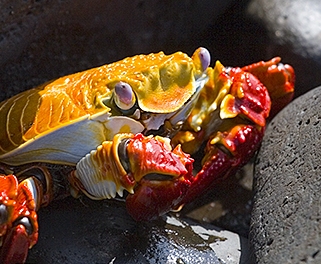Our Route Through the Galapagos Islands

(Refresh page if you want to see the animated tour again.)
We arrived at noon on Baltra Island which features a small airstrip as airport. A bag check upon entering the Galapagos Archipelago ensures that no foreign plants are introduced via seeds.
Baltra Island Airport

End of the Runway

Arriving


The already waiting bus drove us to the bay in which the MS Polaris, our home for the next 8 days, anchored. The Polaris is 72 meters long and 13 meters wide. She is powered by two 1,650 horsepower diesel engines and a 380 horsepower bow thruster. It takes a total of 42 crew members to keep the ship up and running as a floating expedition base. This does not include the five naturalists on board who guide the groups to the various outings.
MS Polaris




Lobby of the MS Polaris


Daily News Posted by Expedition Leader Paula Tangle

E-Mail Room

Lounge with Plasma Screen

Presentation Area for Naturalists During our Daily Debriefing

Mini Bar with Coffee and Soda

At the dock, we could observe three sleeping Galapagos Sea Lions (Zalophus galapagensis) at the landing area which occupied the two benches erected for the tourists. Nobody dared to take a seat next to the sleeping animals. Our guides told us that the large male was known to be grumpy when awoken.
A ten-minute zodiac ride with tightly secured live vests brought us to the Polaris. Lindblad staff had made sure that there were kids vests available for Alexandra and Sophia. We boarded the ship via a landing platform and were welcomed by our "hotel" staff who showed us to our cabins. Shortly afterwards we had our first orientation about the ships amenities and rules. A three-course lunch was followed by an abandon-ship drill were we learned the basics on how to handle an emergency situation.
Our Cabin

Welcome Drinks in the Longue

Expedition Leader, Paula

At 4.30 p.m. we started our first outing into the Galapagos wilderness, a Zodiac cruise along the northwest coast of Santa Cruz Island, to a place called Cerro Dragon, more specifically, the islets of Venecia.
The First Zodiac Ride

The Zodiac cruise - referred to locally as a panga ride - gave us our first impressions of the dramatic volcanic landscape of the Galapagos and the extraordinary life forms that have established themselves here. The islets were characterized by (introduced) mangroves. We were greeted by Blue-footed Boobies (Sula nebouxii) throning on big rocks and fishing in the shallow waters. Entering the deeper parts of the mangroves, we observed the colorful Sally Lightfoot Crabs (Sophia's favorite animal), Frigate Birds, Great Blue Herons (Ardea herodias) and Lava Heron (Butorides sundevalli). But, we also had a first glimpse at an orange-colored Land Iguana (Conolophus subcristatus) as well as black-colored Marine Iguanas (Amblyrhynchus cristatus). A small bay was the living space of several three-foot long Green Sea Turtles (Chelonia agassizii) which broke the water surface several times for breathing; but also housed White-tipped (Triaenodon obesus) and Black-tipped Sharks (Carcharninus limbatus).
Cacti on Volcanic Islet

Sally Lightfoot Crab

Blue-footed Boobies (Sula nebouxii)






Brown Pelican (Pelecanus occidentalis)

Cruise Videographer

Great Blue Heron (Ardea herodias)

Land Iguana (Conolophus subcristatus)

Lava Heron (Butorides sundevalli)

Sally Lightfoot Crab

Marine Iguana (Amblyrhynchus cristatus)

Two hours later, on our way back to the Polaris the sun set. The Blue-footed Boobies were still shooting into the water catching fish. Upon return, Gisela received a complimentary 3 minutes massage treatment by the ship's masseuse, a service of the onboard LexSpa.
Expedition Leader Paula Demonstrating the Sign for Shark
The evening ended with a welcome cocktail hosted by Captain Fausto and an introduction of the crew. The very festive four-course dinner was delicious and at around 9 p.m. we literally fall into our beds.


